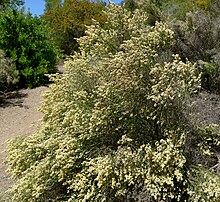
Back بكاريس Arabic بكاريس ARZ Ch'illkha Aymara Bakxaris Azerbaijani Baccharis Catalan Baccharis CEB Korsrod Danish Baccharis German Baccharis Spanish Baccharis Finnish
| Baccharis | |
|---|---|

| |
| Flowering Baccharis articulata | |
| Scientific classification | |
| Kingdom: | Plantae |
| Clade: | Tracheophytes |
| Clade: | Angiosperms |
| Clade: | Eudicots |
| Clade: | Asterids |
| Order: | Asterales |
| Family: | Asteraceae |
| Subfamily: | Asteroideae |
| Tribe: | Astereae |
| Subtribe: | Baccharidinae |
| Genus: | Baccharis L.[1] |
| Species | |
|
Some 250-400, see text | |
| Synonyms[2] | |
| |
Baccharis /ˈbækərɪs/[3] is a genus of perennials and shrubs in the aster family (Asteraceae). They are commonly known as baccharises but sometimes referred to as "brooms", because many members have small thin leaves resembling the true brooms. They are not at all related to these however, but belong to an entirely different lineage of eudicots. B. halimifolia is commonly known as "groundsel bush", however true groundsels are found in the genus Senecio.
Baccharis, with over 500 species, is one of the largest genera in the Asteraceae. It is found throughout the Americas, distributed mainly in the warmer regions of Brazil, Argentina, Colombia, Chile and Mexico,[4] with B. halimifolia ranging northward along the Atlantic Coast to the southern tip of Nova Scotia in Canada.[5]
If present, the leaves of Baccharis are borne along the stems in alternate fashion. Flowers are usually white or pinkish. There are no ray flowers, but many disk flowers which are either staminate or pistillate.
Some species of Baccharis are toxic to animals; in particular, consumption of B. coridifolia may lead to necrosis in the gastrointestinal tract of cattle, horses, sheep, and rabbits.
The genus Baccharis is named after Bacchus (Dionysus), the Roman god of wine.[6]
- ^ Linnaeus 1753, p. 860.
- ^ "Baccharis L." Plants of the World Online. Royal Botanic Gardens, Kew. 2023. Retrieved 16 June 2023.
- ^ Sunset Western Garden Book, 1995:606–607
- ^ http://www.arkat-usa.org/get-file/19602/ Baccharis (Compositae) - Maria José Abad* and Paulina Bermejo
- ^ "Species at Risk Conservation Fund 2009 Approved Projects". Nova Scotia Canada Department of Natural Resources. Retrieved 11 October 2011.
- ^ Cite error: The named reference
fnawas invoked but never defined (see the help page).